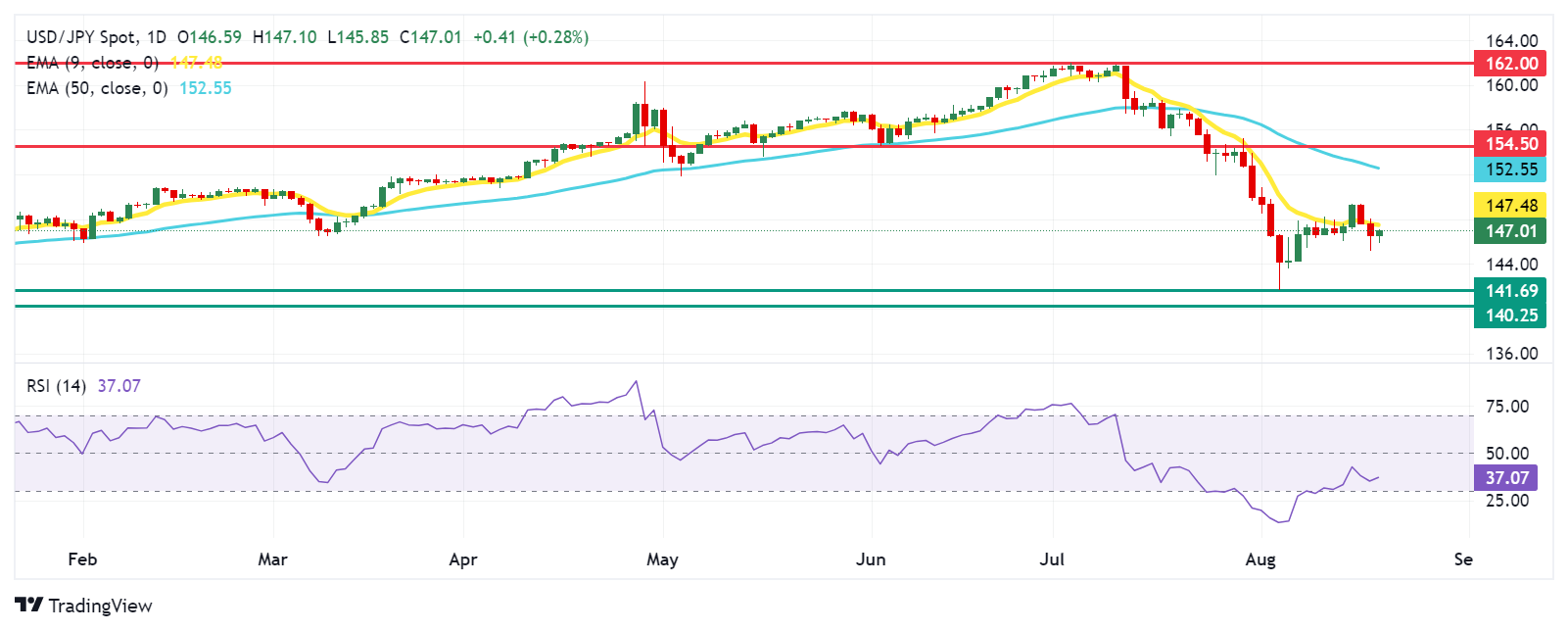- The downside of the Japanese Yen could be limited as BoJ is highly expected to implement further rate hikes.
- Recent economic growth in Japan raises the possibility of another near-term BoJ rate hike.
- The US Dollar gains ground as Treasury yields attempt to retrace recent losses.
The Japanese Yen (JPY) declines against the US Dollar (USD) on Tuesday. However, the downside of the JPY could be restrained amid the rising possibility of another near-term interest rate hike. Japan's economy grew at an annualized rate of 3.1% in the second quarter, significantly exceeding expectations and rebounding from a slowdown earlier in the year.
According to Reuters, the Bank of Japan (BoJ) had projected that a strong economic recovery would help inflation reach its 2% target sustainably. This would justify further interest rate increases, following last month's hike as part of the BoJ's ongoing effort to unwind years of extensive monetary stimulus. On Friday, BoJ Governor Kazuo Ueda is set to discuss the central bank's decision last month to raise interest rates.
The US Dollar (USD) retraces its recent losses due to risk aversion sentiment. However, the Greenback faced challenges after remarks from Federal Reserve (Fed) officials heightened the prospect of upcoming rate cuts. On Monday, Minneapolis Fed President Neel Kashkari suggested that it would be appropriate to consider potential US interest rate cuts in September, citing concerns about a weakening labor market, according to Reuters.
Daily Digest Market Movers: Japanese Yen depreciates despite a hawkish BoJ
- Federal Reserve Bank of San Francisco President Mary Daly emphasized Sunday that the US central bank should take a gradual approach to reducing borrowing costs, according to the Financial Times. Additionally, Federal Reserve Bank of Chicago President Austan Goolsbee warned that central bank officials should be cautious about keeping a restrictive policy in place longer than necessary, per CNBC.
- On Thursday, Kazutaka Maeda, an economist at Meiji Yasuda Research Institute, said that the reports are simply positive overall and “it supports the BoJ’s view and bodes well for further rate hikes, although the central bank would remain cautious as the last rate increase had caused a sharp spike in the Yen.”
- Japanese Economy Minister Yoshitaka Shindo stated that the economy is anticipated to recover gradually as wages and income improve. Shindo also added that the government will collaborate closely with the Bank of Japan to implement flexible macroeconomic policies.
- Japan's Gross Domestic Product (GDP) grew by 0.8% quarter-on-quarter in Q2, surpassing market forecasts of 0.5% and rebounding from a 0.6% decline in Q1. This marked the strongest quarterly growth since Q1 of 2023. Meanwhile, the annualized GDP growth reached 3.1%, exceeding the market consensus of 2.1% and reversing a 2.3% contraction in Q1. This was the strongest yearly expansion since Q2 of 2023.
- US headline Consumer Price Index (CPI) rose 2.9% year-over-year in July, slightly down from the 3% increase in June and below market expectations. The Core CPI, which excludes food and energy, climbed 3.2% year-over-year, a slight decrease from the 3.3% rise in June but aligned with market forecasts.
- Rabobank's senior FX strategist, Jane Foley, observes that this week's series of US data releases, along with next week's Jackson Hole event, should provide the market with clearer insights into the potential responses of US policymakers. However, their main expectation is that the Fed will reduce rates by 25 basis points in September and likely cut them again before the end of the year.
Technical Analysis: USD/JPY hovers around 146.50
USD/JPY trades around 146.60 on Tuesday. Analysis of the daily chart shows that the pair is just below the nine-day Exponential Moving Average (EMA), indicating a short-term bearish trend. Furthermore, the 14-day Relative Strength Index (RSI) is slightly above 30, suggesting a potential correction for the pair.
For support levels, the USD/JPY pair might test the seven-month low of 141.69, which was reached on August 5. A further drop could drive the pair toward the next significant support level at 140.25.
On the upside, the USD/JPY pair could encounter immediate resistance around the nine-day Exponential Moving Average (EMA) at 147.41. If the pair breaks above this level, it might target the 50-day EMA at 152.54 and potentially test the resistance level at 154.50, which has transitioned from previous support to current resistance.
USD/JPY: Daily Chart
Japanese Yen PRICE Today
The table below shows the percentage change of Japanese Yen (JPY) against listed major currencies today. Japanese Yen was the weakest against the Swiss Franc.
| USD | EUR | GBP | JPY | CAD | AUD | NZD | CHF | |
|---|---|---|---|---|---|---|---|---|
| USD | 0.08% | -0.03% | 0.04% | -0.09% | 0.12% | -0.56% | -0.26% | |
| EUR | -0.08% | -0.12% | -0.02% | -0.16% | 0.06% | -0.33% | -0.35% | |
| GBP | 0.03% | 0.12% | 0.10% | -0.04% | 0.19% | -0.22% | -0.25% | |
| JPY | -0.04% | 0.02% | -0.10% | -0.12% | 0.08% | -0.31% | -0.33% | |
| CAD | 0.09% | 0.16% | 0.04% | 0.12% | 0.20% | -0.17% | -0.21% | |
| AUD | -0.12% | -0.06% | -0.19% | -0.08% | -0.20% | -0.39% | -0.43% | |
| NZD | 0.56% | 0.33% | 0.22% | 0.31% | 0.17% | 0.39% | -0.04% | |
| CHF | 0.26% | 0.35% | 0.25% | 0.33% | 0.21% | 0.43% | 0.04% |
The heat map shows percentage changes of major currencies against each other. The base currency is picked from the left column, while the quote currency is picked from the top row. For example, if you pick the Japanese Yen from the left column and move along the horizontal line to the US Dollar, the percentage change displayed in the box will represent JPY (base)/USD (quote).
Bank of Japan FAQs
The Bank of Japan (BoJ) is the Japanese central bank, which sets monetary policy in the country. Its mandate is to issue banknotes and carry out currency and monetary control to ensure price stability, which means an inflation target of around 2%.
The Bank of Japan has embarked in an ultra-loose monetary policy since 2013 in order to stimulate the economy and fuel inflation amid a low-inflationary environment. The bank’s policy is based on Quantitative and Qualitative Easing (QQE), or printing notes to buy assets such as government or corporate bonds to provide liquidity. In 2016, the bank doubled down on its strategy and further loosened policy by first introducing negative interest rates and then directly controlling the yield of its 10-year government bonds.
The Bank’s massive stimulus has caused the Yen to depreciate against its main currency peers. This process has exacerbated more recently due to an increasing policy divergence between the Bank of Japan and other main central banks, which have opted to increase interest rates sharply to fight decades-high levels of inflation. The BoJ’s policy of holding down rates has led to a widening differential with other currencies, dragging down the value of the Yen.
A weaker Yen and the spike in global energy prices have led to an increase in Japanese inflation, which has exceeded the BoJ’s 2% target. With wage inflation becoming a cause of concern, the BoJ looks to move away from ultra loose policy, while trying to avoid slowing the activity too much.
Information on these pages contains forward-looking statements that involve risks and uncertainties. Markets and instruments profiled on this page are for informational purposes only and should not in any way come across as a recommendation to buy or sell in these assets. You should do your own thorough research before making any investment decisions. FXStreet does not in any way guarantee that this information is free from mistakes, errors, or material misstatements. It also does not guarantee that this information is of a timely nature. Investing in Open Markets involves a great deal of risk, including the loss of all or a portion of your investment, as well as emotional distress. All risks, losses and costs associated with investing, including total loss of principal, are your responsibility. The views and opinions expressed in this article are those of the authors and do not necessarily reflect the official policy or position of FXStreet nor its advertisers. The author will not be held responsible for information that is found at the end of links posted on this page.
If not otherwise explicitly mentioned in the body of the article, at the time of writing, the author has no position in any stock mentioned in this article and no business relationship with any company mentioned. The author has not received compensation for writing this article, other than from FXStreet.
FXStreet and the author do not provide personalized recommendations. The author makes no representations as to the accuracy, completeness, or suitability of this information. FXStreet and the author will not be liable for any errors, omissions or any losses, injuries or damages arising from this information and its display or use. Errors and omissions excepted.
The author and FXStreet are not registered investment advisors and nothing in this article is intended to be investment advice.
Recommended content
Editors’ Picks

EUR/USD regains traction above 1.1000 ahead of US CPI release
EUR/USD has found fresh buyers and jumps above 1.1000 in the European session on Thursday. The pair gains on the German coalition deal and Trump's 90-day pause on reciprocal tariffs, which have lifted risk senitment while exacerbating the US Dollar pain ahead of the US CPI data release.

GBP/USD trades firm above 1.2850, US CPI data awaited
GBP/USD sustains the rebound above 1.2850 in European trading hours on Thursday. The British Pound capitalizes on risk appetite, courtesy of Trump's tariff pause, allowing the pair to recover ground. But further upside hinges on the US CPI data and US-Sino trade updates.

Gold price eases from weekly top amid risk-on mood; still well bid above $3,100 ahead of US CPI
Gold price trims a part of its strong intraday gains to a one-week high touched during the early European session on Thursday and currently trades just above the $3,100 mark. Concerns about escalating US-China trade tensions, along with fears about a tariffs-driven economic slowdown, turn out to be key factors that continue to underpin the safe-haven bullion.

US CPI data set to reveal March inflation dip as markets weigh impact of Trump’s tariffs
As measured by the CPI, inflation in the US is set to rise at an annual pace of 2.6% in March, down slightly from the 2.8% reported in February. Core CPI inflation, which excludes the volatile food and energy categories, is expected to ease to 3% in the same period from a year earlier

Trump’s tariff pause sparks rally – What comes next?
Markets staged a dramatic reversal Wednesday, led by a 12% surge in the Nasdaq and strong gains across major indices, following President Trump’s unexpected decision to pause tariff escalation for non-retaliating trade partners.

The Best brokers to trade EUR/USD
SPONSORED Discover the top brokers for trading EUR/USD in 2025. Our list features brokers with competitive spreads, fast execution, and powerful platforms. Whether you're a beginner or an expert, find the right partner to navigate the dynamic Forex market.




